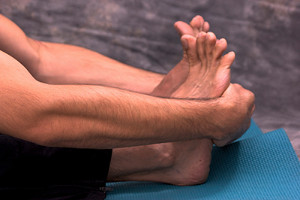6650 Frankford Ave
Philadelphia, PA 19135

The sport of soccer demands rigorous physical activity that put players at risk of injuries, particularly injuries affecting the lower extremities. Ankle and foot injuries, including sprains, strains, and fractures, are common among soccer players due to the frequent pivoting, cutting, and sudden changes in direction inherent in the game. These injuries often result from player contact, falls, or improper landing techniques. Preventive measures include proper conditioning and gradual intensity progression in training. Wearing appropriate protective gear, including well-fitted shin guards and supportive footwear, is extremely important. Ankle taping or bracing can significantly decrease injury occurrence and recurrence rates. If you have sustained a foot or ankle injury from playing soccer, it is suggested that you schedule an appointment with a podiatrist as quickly as possible for a diagnosis and treatment options.
Sports related foot and ankle injuries require proper treatment before players can go back to their regular routines. For more information, contact John M. Fanelly, DPM of Northeast Philadelphia. Our doctor can provide the care you need to keep you pain-free and on your feet.
Sports Related Foot and Ankle Injuries
Foot and ankle injuries are a common occurrence when it comes to athletes of any sport. While many athletes dismiss the initial aches and pains, the truth is that ignoring potential foot and ankle injuries can lead to serious problems. As athletes continue to place pressure and strain the area further, a mild injury can turn into something as serious as a rupture and may lead to a permanent disability. There are many factors that contribute to sports related foot and ankle injuries, which include failure to warm up properly, not providing support or wearing bad footwear. Common injuries and conditions athletes face, including:
Sports related injuries are commonly treated using the RICE method. This includes rest, applying ice to the injured area, compression and elevating the ankle. More serious sprains and injuries may require surgery, which could include arthroscopic and reconstructive surgery. Rehabilitation and therapy may also be required in order to get any recovering athlete to become fully functional again. Any unusual aches and pains an athlete sustains must be evaluated by a licensed, reputable medical professional.
If you have any questions please feel free to contact our office located in Philadelphia, PA . We offer the newest diagnostic and treatment technologies for all your foot and ankle needs.

One of the most concerning complications of diabetes is the risk of foot amputation. However, with proper management and proactive measures, many cases of foot amputation can be prevented entirely. A few significant ways to prevent amputation are effectively managing blood sugar levels, diligent foot care, and exercise. Adopting a healthy diet, performing daily foot inspections, and including regular exercise in your daily routine is essential for diabetic patients. Daily foot inspections can identify any abnormalities such as redness, wounds, bruising, blisters, or discoloration before they escalate into ulcers. For those with limited mobility or visibility, using a magnifying mirror or enlisting the help of a caregiver for foot checks is imperative. Regularly assessing foot sensation and temperature sensitivity is also vital in detecting neuropathy, a common complication of diabetes. Other simple measures such as wearing clean, dry socks without elastic bands, wiggling toes, and moving ankles frequently can improve blood circulation in the feet. Any signs of foot problems or neuropathy symptoms, such as numbness, burning, or tingling should be promptly reported to your podiatrist. It is suggested that diabetic individuals schedule regular visits with type of doctor for help in preventing the loss of a limb.
Diabetic Limb Salvage
Diabetic limb salvage can be an effective way in preventing the need for limb amputation. If you have a foot ulcer and diabetes, consult with John M. Fanelly, DPM from Northeast Philadelphia. Our doctor will assess your condition and provide you with quality foot and ankle treatment.
What Is Diabetic Limb Salvage?
Diabetic limb salvage is the attempt of saving a limb, such as the foot, that has an infected ulcer, from amputation. Podiatrists also try to make sure that there is enough function in the foot after the salvage that it is still usable. Those with diabetes experience poor blood circulation, which prevents proper healing of an ulcer. If the ulcer is left uncheck, it could become infected, which could result in the need for amputation.
Diabetes is the number one cause of non-traumatic amputations in the United States. Amputation has been found to lead to higher mortality rates. This translates into higher healthcare costs, and a reduced quality of life and mobility for amputees. Podiatrists have attempted to increase the prevalence of limb salvage in an attempt to solve these issues.
Diagnosis and Treatment
Limb salvage teams have grown in recent years that utilize a number of different treatments to save the infected limb. This includes podiatrists that specialize in wound care, rehabilitation, orthotics, and surgery. Through a combination of these methods, limb salvage has been found to be an effective treatment for infected limbs, and as an alternative to amputation. Podiatrists will first evaluate the potential for limb salvage and determine if the limb can be saved or must be amputated.
If you have any questions, please feel free to contact our office located in Philadelphia, PA . We offer the newest diagnostic and treatment technologies for all your foot care needs.

Hansen's disease, commonly known as leprosy, is a bacterial infection caused by Mycobacterium leprae. One of its hallmark symptoms is the loss of sensation in various parts of the body, including the feet. This sensory loss occurs due to the bacteria's damaging effects on peripheral nerves. As the disease progresses, it can lead to nerve damage and the loss of the ability to feel pain, temperature changes, and touch in the affected areas, including the feet. This sensory impairment can result in injuries and wounds going unnoticed, which may lead to secondary infections and complications. The loss of sensation in the feet is particularly concerning because it can hinder mobility and self-care, making early detection and treatment crucial in preventing severe deformities and disabilities associated with Hansen's disease. Creating orthotics for individuals without sensation requires extra care as they cannot provide feedback on fit and comfort. Frequent skin inspections are necessary to prevent irritation and skin breakdown. Custom orthotics can be made by molding the material directly to the patient's foot. Contours may be added for pressure relief, and localized relief can be achieved with various tools. Monitoring foot health closely with new shoes and orthotics is vital, looking for signs of redness, temperature changes, calluses, swelling, pre-ulceration, or recurrent ulcers. Prompt attention to pressure signs helps prevent ulcers. Orthotic selection depends on the degree of sensation loss, deformity, ulceration, and callus development. If you have Hansen’s disease and you have a loss of sensation in your feet, it is suggested that you make an appointment with a podiatrist to discuss whether orthotics can help you.
If you are having discomfort in your feet and would like to try orthotics, contact John M. Fanelly, DPM from Northeast Philadelphia. Our doctor can provide the care you need to keep you pain-free and on your feet.
What Are Orthotics?
Orthotics are inserts you can place into your shoes to help with a variety of foot problems such as flat feet or foot pain. Orthotics provide relief and comfort for minor foot and heel pain but can’t correct serious biomechanical problems in your feet.
Over-the-Counter Inserts
Orthotics come in a wide variety of over-the-counter inserts that are used to treat foot pain, heel pain, and minor problems. For example, arch supports can be inserted into your shoes to help correct overarched or flat feet, while gel insoles are often used because they provide comfort and relief from foot and heel pain by alleviating pressure.
Prescription Orthotics
If over-the-counter inserts don’t work for you or if you have a more severe foot concern, it is possible to have your podiatrist prescribe custom orthotics. These high-quality inserts are designed to treat problems such as abnormal motion, plantar fasciitis, and severe forms of heel pain. They can even be used to help patients suffering from diabetes by treating foot ulcers and painful calluses and are usually molded to your feet individually, which allows them to provide full support and comfort.
If you are experiencing minor to severe foot or heel pain, it’s recommended to speak with your podiatrist about the possibilities of using orthotics. A podiatrist can determine which type of orthotic is right for you and allow you to take the first steps towards being pain-free.
If you have any questions please contact our office located in Philadelphia, PA . We offer the newest diagnostic and treatment technologies for all your foot and ankle needs.

In the quest for overall health and vitality, the incredible benefits that come from incorporating foot and toe stretching into our daily routine is often overlooked. Stretching not only improves flexibility but also plays a vital role in enhancing the strength and mobility of the feet. These simple yet effective exercises promote better blood circulation, alleviating tension and reducing the risk of common foot issues. Regular stretching can contribute to improved posture, balance, and stability, benefiting not only the feet but the entire musculoskeletal system. Additionally, toe stretching exercises can prevent and alleviate discomfort associated with conditions like plantar fasciitis and toe deformities. Embracing a consistent routine of gentle stretches not only revitalizes tired feet but also fosters a sense of relaxation and well-being. If you are interested in learning about what type of foot and toe stretches to perform, it is suggested that you consult a podiatrist.
Stretching the feet is a great way to prevent injuries. If you have any concerns with your feet consult with John M. Fanelly, DPM from Northeast Philadelphia. Our doctor will assess your condition and provide you with quality foot and ankle treatment.
Stretching the Feet
Stretching the muscles in the foot is an important part in any physical activity. Feet that are tight can lead to less flexibility and make you more prone to injury. One of the most common forms of foot pain, plantar fasciitis, can be stretched out to help ease the pain. Stretching can not only ease pain from plantar fasciitis but also prevent it as well. However, it is important to see a podiatrist first if stretching is right for you. Podiatrists can also recommend other ways to stretch your feet. Once you know whether stretching is right for you, here are some excellent stretches you can do.
It is best to go easy when first stretching your foot and work your way up. If your foot starts hurting, stop exercising and ice and rest the foot. It is advised to then see a podiatrist for help.
If you have any questions, please feel free to contact our office located in Philadelphia, PA . We offer the newest diagnostic and treatment technologies for all your foot care needs.